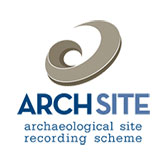An Archaeological Wander Round Aotearoa New Zealand, or, What Can We Learn from ArchSite?
Mary O’Keeffe
ArchSite Central Filekeeper, April 2020
Remind me – what’s ArchSite?
ArchSite is the online version of the NZ Archaeological Association’s Site Recording Scheme. The site recording scheme was originally a paper based system, and in recent years an online index of this paper system has been developed, called ArchSite.
Where and when did it all start?
People have been observing and documenting archaeological sites in New Zealand since the late 1800s. But in the 1960s archaeologists in New Zealand saw a need for a systematic way to record sites, and established the site recording scheme.
The first recorded site, N1/1 (metric number N02/1) is a pa in Northland, recorded in 1964.
The first South Island site, S1/1 (metric number M24/24) is a midden and artefacts noted on the ground surface after ploughing on Farewell Spit, recorded in 1966.
The recording system still in use was first mooted in 1951, when the Historical Section of the Hawkes Bay Branch of the Royal Society was given a financial grant to be used “for the investigation of a suitable scheme whereby sites related to early Maori Occupation might be recorded in a simple but systematic way”. Recording forms based on those used by the Geological Society were adapted. The scheme and forms were tested, and NZAA approved the scheme for site recording in principle at its meeting in May 1958 (Mumford 1959: 8-9).
The first forms were abandoned in 1960, and forms with headings closer to those in use today were developed (Mumford 1960: 33).
Jack Golson and Roger Green produced the “Handbook to Field Recording” in 1958. This important publication was revised by John Daniels in 1970 and renamed “New Zealand Archaeology – a Site Recording Handbook”. Many New Zealand archaeologists still have a faded, well-used and well-thumbed, dirty-from-being-in-your-fieldbag copy of this on their bookshelves somewhere.
Another interesting thing is how the purpose and point of the Site Recording Scheme has changed over the decades. Originally it was a record of observed sites, that may or may not have been investigated or excavated. The original scheme was to record Maori sites, but it was later expanded to include Pakeha sites.
In 1979 John Daniels noted with regret “… the gradual shift in emphasis from the use of the scheme as a research tool to its unfortunate but vital role in site protection” (Daniels 1979: 5). This protection role has grown over successive decades, mainly in response to legislation changes, notably the Resource Management Act 1991.
Today ArchSite is used by a wide variety of users for a wide variety of purposes: archaeologists undertaking cultural resource management work, archaeologists undertaking research (lucky them!), land managers, iwi manging their resources and wahi taonga, city district and regional councils, and many others.
So what’s in ArchSite?
From that first site in 1964, today ArchSite contains just over 74,000 sites.
It is important to remember that a large number of these sites were recorded by people in a voluntary capacity – local archaeological groups, archaeologists out for a walk, or undertaking a deliberate survey but on their own time. While most recording now is by professional archaeologists undertaking surveys or assessments for statutory outcomes, many people are still out there recording sites in their own time, to contribute data and for the sheer pleasure of it.
74% of all the sites are of Maori origin, 16% are of non-Maori origin, and 2% are a combination.
The 74,000 sites look like this across the country:

What can this data tell us?
The site data can tell a vivid and interesting story about peoples’ activity and lifestyle. The relationship between site distribution and topography is fascinating. Looking at sites of precontact Maori origin, we can see a preference for the coast, and for rivers. This tells a story of people who travelled primarily by water – they used the coast for food and resources, but also used the coast as a highway. River were highways to inland locations and resources.
We can see this in northern Hawkes Bay and Gisborne:

And along the Waikato River valley:

And up the Canterbury and Otago rivers and routes to the inland lakes:

Maori also explored every corner of New Zealand: sites are found in the most remote parts of Fiordland (again using the coast and rivers as the highway):

However it’s important to be aware of another aspect of this site distribution data – it also shows where archaeologists have been. In other words, just because an area appears to be “empty” of sites, it may not be – the apparent lack of sites may just reflect that no archaeologist has been along to record the sites that may be there.
Site density tells us a lot about lifestyle preferences. Not surprisingly, the further north in the country we go, the denser is the site distribution. People’s fundamental preferences have always been the same – we like to live in the sun, preferably with a nice view, and close to the shops.
An analysis by region throws up an interesting picture:

The regions with the largest percentage of sites are Northland, with 17%, then Auckland, with 15%, then Bay of Plenty and Waikato, each with 14%.
All of these places are sunny, have extensive coasts or long navigable rivers, and are just jolly nice places to live.
In some places site density is extraordinary, and visually dramatic. This can be seen in Northland:

Or in the Western Bay of Plenty:

Notably, these regions with great site density are also experiencing population pressure through growth today – this seems to have been the trend for several hundred years.
Interestingly, the region with the next highest percentage of site is Otago, probably reflecting the rich resources available in Otago and Central Otago, through stone sources and abundance of moa.
What kind of sites are there?
ArchSite contains a broad and fascinating range of evidence of peoples’ activities – the places they lived, what they ate, how they grew or caught their food, the technology they used, their past times and art, and stages of life such as death.
The greatest number of recorded sites are middens. This is not surprising for several reasons – the recording scheme started with a focus on Maori sites, and middens can be visually easy to spot. 27% of the sites in ArchSite are middens. Arguably they could be called the universal site – they are found everywhere in New Zealand:

Pits and terraces have the next highest occurrence in ArchSite; they account for 26% of all sites. Like middens, they occur in all parts of the country, but with a visually dramatic trend to the North Island:

Pa are the next most common site type, accounting for 9% of sites, and with a clear bias for North Island locations:

The range of sites in ArchSite is fantastically varied, and reflect the huge range of activities that people have engaged in for the last few hundreds of years.
There are 129 shipwrecks – and not all of them on the coast:

There is a truly wonderful range of Maori Art sites- rock art, dendroglyphs on trees, incised rock carvings, and others:

Gold mining is found on both islands, and accounts for 5% of all sites:

And what else is there? – mutton birding sites, stone lined fishponds, hospitals, cottages, rubbish pits full of fascinating artefacts, stockades and muskets trenches, roads, drains, WW2 tank traps, copper mines, stands of karaka trees, carved karaka trees, gardening sites ….the list is endless.
All of these sites are evidence of what people have been doing to shape our community and society. The sites tell a wonderful creative diverse story of human ingenuity, adaption to new lands and new resources, and people getting on with their lives.
Where can I take a look?
Head to http://www.archsite.org.nz/, and you can look at the free interactive map. A more detailed view requires a paid account – ask at admin@archsite.org.nz for more information.
References
Daniels, J. 1979. New Zealand Archaeology – A Site Recording Handbook (2nd ed). Monograph 10 of the New Zealand Archaeological Association.
Mumford, W. 1959 Field Recording Scheme. In NZ Archaeological Association Newsletter Vol 2 pp7-12
Mumford W. 1960 Revision of the Site Recording Scheme. In NZ Archaeological Association Newsletter Vol 3 pp33-35




